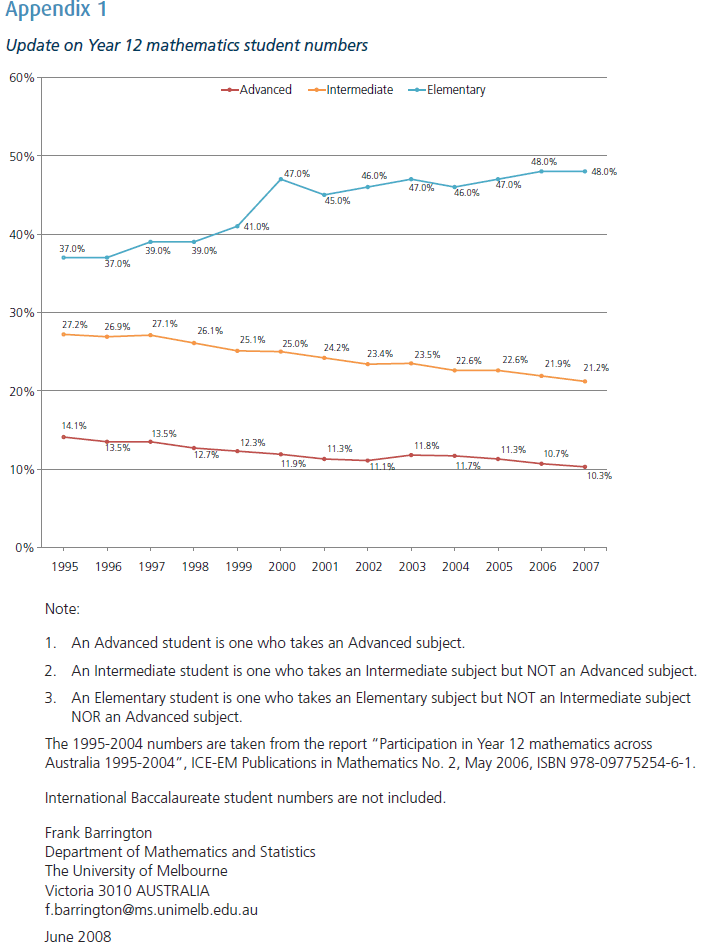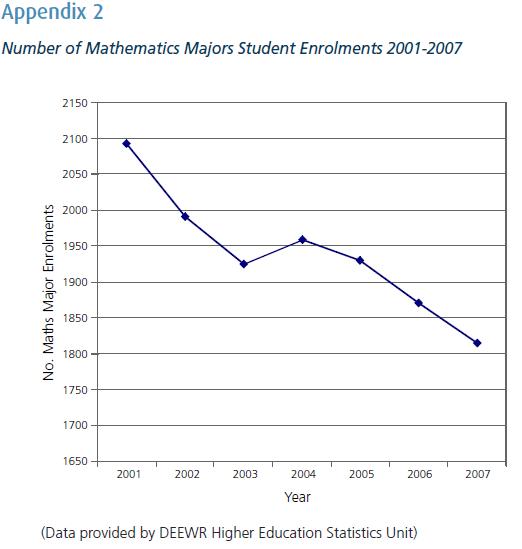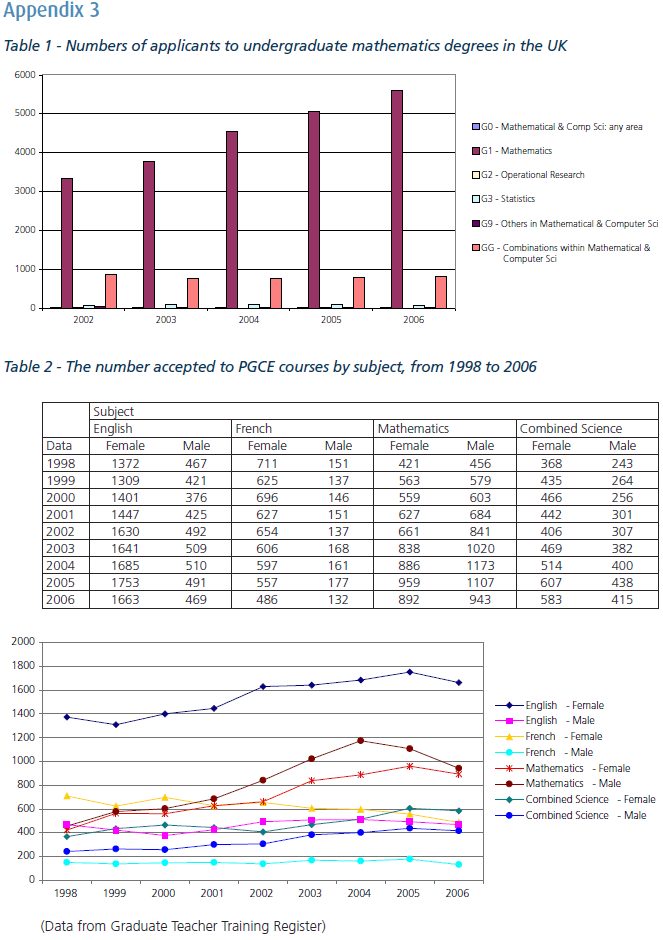|
|
|
|
|
|
|
News & Views item - March 2009 |
![]() Support for Australian Maths a Growing Imperative. (March 4, 2009)
Support for Australian Maths a Growing Imperative. (March 4, 2009)
|
|
| Professor Hyam Rubinstein |
Today marks the opening day of the 2009 three-day national conference in Canberra on the future of higher education in Australia. It involves over 300 delegates including the vice-chancellors of 39 Australian universities.
According to Universities Australia chief executive Dr Glenn Withers a range of key issues are listed for discussion: "The future of Federal Government policy, whether it will re-balance towards a better and proper [financial] support as we see it, and how we deal with things like the global financial crisis and wider issues such as social inclusion and climate change."
Federal Education Minister Julia Gillard and the Minister for Innovation, Industry, Science and Research Kim Carr are scheduled to attend, but how long they will stay to listen is problematic, though it is likely that one or more of their staffs will be detailed to spend time with conferees.
One of the matters almost sure NOT to get much attention from the delegates, let alone the ministers, is the continued decline in the representation of the mathematical sciences in teaching and research at all educational levels.
Funny that, because if language is the foundation of modern civilization, mathematics is its key stone.
Yesterday the Australian Mathematical Sciences Institute issued an eleven page
apologia
A National Strategy for Mathematical Sciences in Australia![]() written by the chair of the National Committee for the Mathematical Sciences,
Melbourne University professor Hyam Rubinstein.
written by the chair of the National Committee for the Mathematical Sciences,
Melbourne University professor Hyam Rubinstein.
Here in outline are the points raised:
The Challengers:
Demand for mathematics and statistics graduates—and graduates with substantive mathematics within other degrees such as engineering and economics—in the Australian economy has outstripped supply in recent years and is forecast to continue doing so.
Demand for mathematics teachers continues to be an area of particular pressure.
Unsurprisingly, the quality of mathematics education has declined in Australia over the past decade.
Should current trends in tertiary mathematics education continue, there is little prospect of turning the situation around.
This is devastating since it will lead to rising inequality in access to mathematics education for young Australians.
There are worrying ramifications for the
future of Australian science.
The Solutions are discussed under
four headings:
Mathematical sciences and their
importance to Australia.
Mathematical sciences are a hidden achiever. It
is not obvious to the community at large that mathematics and statistics
are critical to the vast majority of technologies they use every day.
Four measures are therefore proposed that would put mathematics and
statistics clearly into the public arena. These measures are intended to
inspire students and their parents to appreciate both the importance of
the mathematical sciences and the many exciting career options that
depend upon developing good mathematical skills.
Well qualified teachers of mathematics in
schools.
If more Australian students are to study advanced
mathematics and if students at all levels are to have an appropriate
number of hours of instruction, it is clear that additional measures
must be taken by our governments. The following seven initiatives
address the current inequity in access to a quality mathematics
education. Inequitable access is now endemic in Australia. The proposed
measures are designed to improve the quality and quantity of mathematics
teaching and learning and provide a mechanism for rewarding good
mathematics teachers in primary and secondary schools.
Mathematical sciences in the university
sector.
Mathematical sciences will never be strong in
Australian schools, communities and businesses without an appropriate
foundation in our universities. However political leadership is needed
if Australia is to develop an outstanding higher education system for
mathematics.
Our universities need to ensure that all Australian students have
access to a major in the mathematical sciences should they wish to
pursue one. The integrity and standard of mathematics and statistics
courses taught outside mathematical sciences departments must be
monitored for content and standards. Our federal government needs to
provide a more strategic use of the HECS reductions to encourage
students to include mathematics and statistics in science degrees. We
also need to be certain that our immigration policies do not cause
Australia to lose in the international competition for mathematical
talent. To these, and related, ends we are proposing eight additional
measures.
Mathematical and statistical
infrastructure.
The Australian Mathematical Sciences Institute (AMSI)
is core infrastructure supporting many activities that simply would not
occur otherwise. An example is an industry workshop in July where the
OECD is funding 15 participants from developing countries. Another
example is the internship program for postgraduate students. Until the
mathematical sciences are rebuilt, AMSI is the only way that Australia
can provide collaborative, national mathematical infrastructure across
the broader research community, business, industry and education.
Through its members and the Australian Council of Heads of Mathematical
Sciences for which it provides administrative support, AMSI is well
placed to provide core support for teaching and research in mathematics
as well as evidence for policy in the mathematical sciences. We are
calling for support for this mathematical and statistical infrastructure
in four ways.
Professor Rubinstein summarises the matter:
A National Strategy
The mathematical sciences are in need of repair. The time has passed when
any single initiative will suffice and a coordinated national strategy is now
required. The issues discussed here should be of concern in every State and
Territory and in every electorate. The inequitable access to a quality
mathematics education is a national disgrace. It will not be solved by isolated
measures.
Many of the proposals put forward concern education. However, mathematical
infrastructure for business, industry and research also concern the Science and
Innovation portfolio. This is where policy for the promotion of science is
currently situated and is where new policies for the promotion of mathematical
sciences may possibly belong.
In recent years, the UK has turned its performance in mathematical sciences and
education around in a remarkable way by combining aggressive teacher recruitment
with substantial inducements, regulation of teacher education numbers to match
demand from schools, an impressive careers program supported by the government
and professional societies, and the designation of mathematics as part of the
strategically important subjects program. Two tables from the London
Mathematical Society concerning applicants for undergraduate mathematics
programs and graduate teacher numbers are shown in Appendix 3.
The truth is Australian mathematics and mathematics education are in a dire
state. But the British example shows that it is possible, by acting
strategically, to turn things around. The mathematical sciences community asks
for a bipartisan, national approach to ensure that similar results can be
achieved in Australia. To quote the 2006 Review:
“Australia is a big country, with a dispersed population. Ensuring a
mathematical sciences base that supports teaching, research, and industry in
remote and rural areas as well as the major population centres is a challenging
task. With sufficient will it can be done.”
_____________________________________


